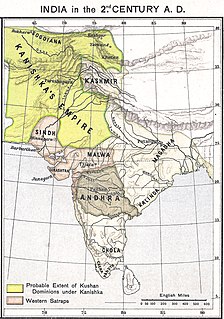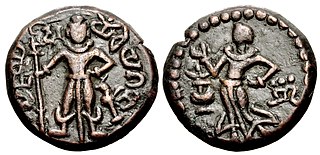
The Kushan Empire was a syncretic empire, formed by the Yuezhi, in the Bactrian territories in the early 1st century. It spread to encompass much of modern-day territory of Afghanistan, Pakistan, and northern India, at least as far as Saketa and Sarnath near Varanasi (Benares), where inscriptions have been found dating to the era of the Kushan Emperor Kanishka the Great.

The Indo-Greek Kingdom, or Graeco-Indian Kingdom, also known historically as the Yavana Kingdom (Yavanarajya), was a Hellenistic-era Greek kingdom covering various parts of Afghanistan and the northwest regions of the Indian subcontinent,. This kingdom was in existence from ca. 200 BC to ca. 1 BC.

Apollodotus I Prakrit in the Kharoshti script: maharajasa apaladatasa tratarasa) was an Indo-Greek king between 180 BC and 160 BC or between 174 and 165 BC who ruled the western and southern parts of the Indo-Greek kingdom, from Taxila in Punjab to the areas of Sindh and possibly Gujarat.

Indo-Scythians were a group of nomadic Iranian peoples of Scythian origin who migrated from Central Asia southward into modern day Pakistan and North Western India from the middle of the 2nd century BC to the 4th century AD.

The Kingdom of Kuninda was an ancient central Himalayan kingdom documented from around the 2nd century BCE to the 3rd century, located in the southern areas of modern Himachal Pradesh and far western areas of Uttarakhand in northern India.

The Triratna is a Buddhist symbol, thought to visually represent the Three Jewels of Buddhism.

Kingdom of Kosala was an ancient Indian kingdom with a rich culture, corresponding the area with the region of Awadh in present-day Uttar Pradesh to Western Odisha. It emerged as a small state during the late Vedic period, with connections to the neighbouring realm of Videha. Kosala belonged to the Northern Black Polished Ware culture, and the Kosala region gave rise to the Sramana movements, including Jainism and Buddhism. It was culturally distinct from the Painted Grey Ware culture of the Vedic period of Kuru-Panchala west of it, following independent development toward urbanisation and the use of iron.

Panchala was an ancient kingdom of northern India, located in the Ganges-Yamuna Doab of the Upper Gangetic plain. During Late Vedic times, it was one of the most powerful states of ancient India, closely allied with the Kuru Kingdom. By the c. 5th century BCE, it had become an oligarchic confederacy, considered one of the solasa (sixteen) mahajanapadas of the Indian subcontinent. After being absorbed into the Mauryan Empire, Panchala regained its independence until it was annexed by the Gupta Empire in the 4th century CE.

The Audumbras, or Audumbaras (Hindi;ओदुम्बर) were a north Indian tribal nation east of the Punjab, in the Western Himalaya region. They were the most important tribe of the Himachal, and lived in the lower hills between Sirmaur, Chamba and Yamuna.

The Bareilly districtpronunciation (help·info) belongs to the state Uttar Pradesh in northern India. Its capital is Bareilly city and it is divided in six administrative division or tehsils: Aonla, Baheri, Bareilly city, Faridpur, Mirganj, and Nawabganj. The Bareilly district is a part of the Bareilly Division and occupies an area of 4120 km2 with a population of 4,448,359 people according to the census of 2011.

Himalaya kingdom was a mountainous country in Himalayas mentioned in the Puranas. In the puranas, Himavat was its ruler and his daughter Parvati was a princess from this kingdom. The Indian epic Mahabharata doesn't mention a kingdom named Himalaya, but mentions many kingdoms in the Himalaya mountains like the Kuninda, Parvata, Nepa, Kirata, Kimpurusha, and Kinnara.

Yaudheya or Yoddheya Gana was an ancient militant confederation. The word Yaudheya is a derivative of the word from yodha meaning warriors. They were principally kshatriya renowned for their skills in warfare, as inscribed in the Junagadh rock inscription of Rudradaman by the Indo-Scythian ruler Rudradaman of the Western Satraps. The Yaudheyas emerged in the 5th century BCE and governed independently until being incorporated into the Maurya Empire. Following the disintegration of the Maurya Empire, the Yaudheyas regained autonomy and ruled as contemporaries to the Shunga Empire and Indo-Greek Kingdoms, and minted their own coinage. However, they were conquered by the Kshatraps led by Rudradaman, and although briefly winning independence, they were then annexed by the Kushan Empire under Kanishka. The Yaudheya Republic reformed and flourished up to the middle to the 4th century when it was ultimately conquered by Samudragupta and incorporated into the Gupta Empire until being disestablished.
Sadhaura is a city with Municipal committee Nagar Palika and a Municipal Corporation in Yamunanagar district in the Indian state of Haryana. A town of Yamunanagar, it is of great historic significance. Sadhaura is very old town many historical temples/Dargah are there like Manokamna Temple, Laxmi narayan Temple, Roza Peer Dargah are some famous places in Sadhaura.

Amogh was a king of the Kuninda Kingdom in northern India, during the late 2nd century BCE to early 1st century BCE.

Abhiraka, also Aubheraka, Aubhirakes, or formerly Aghudaka, was an Indo-Scythian king and a member of the Kshaharata dynasty of the Western Satraps circa 30 CE. He was the father of Bhumaka, and the grandfather of Nahapana.
The Katyuri kings were a medieval Hindu Rajput's ruling clan of Khasha origin from Joshimath that ruled over the regions in present day regions of Kumaon, Uttarakhand in India and parts of Doti/Sudurpashchim Province in Nepal from 700 to 1200 CE. The founder of this dynasty, King Vasu Dev was originally a Buddhist ruler, but later he started following Hindu practices sometimes attributed to a vigorous campaign of Hindu philosopher Adi Shankara.

Uttarakhand is a state in North India. Its name, which means "northern land" or "section" or "northern part" in Sanskrit, is mentioned in early Hindu texts as the combined region of Kedarkhand and Manaskhand.
The Kanet is a caste found in the state of Himachal Pradesh in North India. They are generally regarded as a Thakur (noble) caste, even though they have sometimes been classified otherwise.

Shaka may have been one of the last rulers of the Kushan Empire around 325-345. He may have succeeded Vasudeva II. There is a group of Kushan gold coins that all carry the Brahmi legend Shaka in the right field, in the same place where Vasudeva II's coins read Vasu, so it is natural to suppose that perhaps Shaka was the name of the king who issued these coins. A further support for this idea is that there is a mention of one "Devaputra Shahi Shahanshahi Shaka Murunda" in Samudragupta's famous Allahabad inscription, as one of the rulers who paid him homage. In this context, Shaka could be a title, it could refer to a tribe, or it could be a personal name. In any case, it seems to be related to the Shaka coins. Unfortunately, we don't know the date of the Allahabad inscription, so the best guess on dating Shaka is c. mid-4th century.

Post-Mauryan coinage refers to the period of coinage production in India, following the breakup of the Maurya Empire.
















